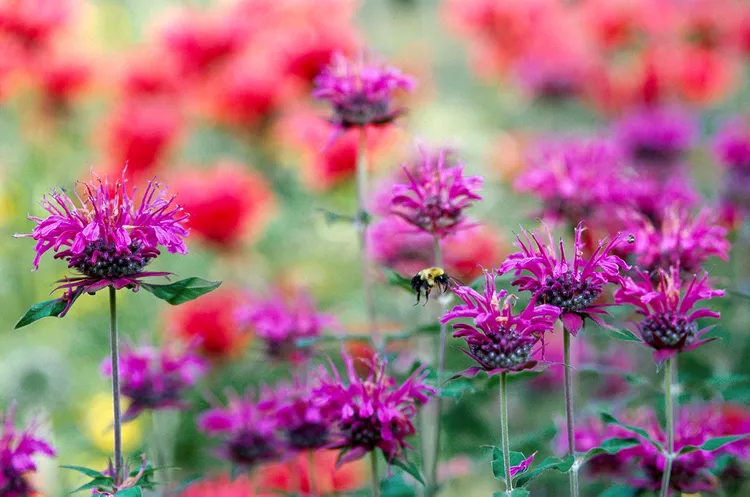Attracting beneficial wildlife to your yard, especially pollinators, is one of the best things you can do for your garden. Bees and butterflies may come to mind, but many other insects, such as moths, wasps, and beetles, also help plants make fruits and seeds by transferring pollen from flower to flower.
However, not just any plant will attract these pollinators to your yard. You need plenty of nectar-rich flowers. Plant some of these 13 nectar-rich beauties in your garden to keep hummingbirds, bees, and other pollinators coming your way.
Anise Hyssop
This upright perennial grows easily from seeds or seedlings and self-sows freely. Anise hyssop (Agastache foeniculum) is heat- and drought-tolerant, and attracts birds. Its scent is a blend of licorice and mint.
Growing Conditions: Part shade to full sun and well-drained soil
Size: Up to 4 feet tall and 3 feet wide
Zones: 4-8
Beardtongue
Beardtongues (Penstemon spp.) are gorgeous native plants that give a variety of pollinators the nectar they're looking for. The tubular flowers come in a variety of colors and bloom at various times. Penstemons attract hummingbirds in particular.
Growing Conditions: Full sun and well-drained soil
Size: Up to 6 feet tall and 3 feet wide
Zones: 3–9
Catmint
Catmint's (Nepeta spp.) show of blooms tends to reach its peak color just as most of the spring bulbs are finishing, but before many summer perennials begin to bloom, easily filling in color during the seasonal transition. This tough perennial excels in hot, dry weather.
Growing Conditions: Full sun to part shade in well-drained soil
Size: Up to 12 inches to 36 inches wide
Zones: 3-9
Torch Lily
Torch lilies (Kniphofia spp.) add unique texture and color to the garden and provide food for pollinators. This flowering perennial—also known as red-hot poker plants—produces nectar throughout the hottest days of summer. Exceptionally easy to grow, red-hot poker is an excellent addition to any full-sun planting spot.
Growing Conditions: Full sun and well-drained soil
Size: Up to 4 feet tall and 3 feet wide
Zones: 5–9
Lavender
Lavender (Lavandula spp.) attracts all sorts of pollinators, but honeybees have a special affinity for the fragrant herb's nectar and pollen. Plant large patches so there's plenty of lavender flowers for harvesting and for the insects.
Growing Conditions: Full sun and well-drained soil
Size: Up to 3 feet tall and 3 feet wide
Zones: 5-9
Spider Flower
Try spider flower (Cleome hassleriana) for a dramatic burst of color. The plants come in pink, purple, or white varieties. Remove spent flowers before seedpods form, or let the plants self-sow.
Growing Conditions: Full sun to part shade and rich, well-drained soil
Size: Up to 5 feet high and 4 feet wide
Zones: annual
Bee Balm
Bee balm (Monarda spp.) is a low-maintenance and deer-resistant native perennial. A magnet for pollinators, this plant blooms from early to late summer. Snip off spent flowers to encourage reblooming.
Growing Conditions: Full sun and moist, rich soil
Size: Up to 4 feet tall and wide
Zones: 3-9
Salvia
Perennial salvias (Salvia spp.) are a large group of plants that will attract bees galore. Faithfully deadheading the plants prompts more flowering. This colorful garden plant is drought-tolerant.
Growing Conditions: Full sun and well-drained soil
Size: Up to 3 feet tall and wide
Zones: 3–10
Fuschia
An ideal plant for hanging baskets, wall pots, and other containers in shaded locations, fuschia (Fuschia spp.) blooms feature two layers of petals—often in different colors—and long stamens. Tender and hardy varieties are spectacular.
Growing Conditions: Full to part shade and evenly moist, well-drained soil
Size: Up to 3 feet tall and 5 feet wide
Zones: 8-10
Thyme
Thyme (Thymus spp.) is a go-to option for attracting lots of pollinators. This large group of herbs includes groundcovers such as creeping thyme, and upright thyme plants. Harvesting thyme throughout the growing season promotes new growth, but you'll need to allow this herb to flower in order to feed pollinators.
Growing Conditions: Full sun and well-drained soil
Size: Up to 18 inches tall and wide
Zones: 4-9
Black-Eyed Susan
Plant a pool of bright yellow in your garden with black-eyed Susan (Rudbeckia spp). The beautiful nectar-rich blooms bring plenty of pollinators to your garden. These plants are also drought-resistant, making them easy to care for. There are several varieties of black-eyed Susan, both annual and perennial, so you'll have plenty of choices when looking for the perfect ones to fit into your landscape.
Growing Conditions: Full sun and well-drained soil
Size: Up to 5 feet tall and 3 feet wide
Zones: 3-11
Purple Coneflower
Purple coneflower (Echinacea purpurea) is a prairie native that attracts bees and other pollinator insects. Besides their nectar-rich blooms, the plant's seeds also attract goldfinches and other seed-eating birds. These shuttlecock-shaped flowers tend to be purplish pink, but newer varieties have expanded the palette to yellow, orange, burgundy, and cream.
Growing Conditions: Full sun and well-drained soil
Size: Up to 3 feet tall
Zones: 3-9
Avoid double-flowered varieties of coneflower because their nectar is harder to access for pollinators.
Yarrow
Yarrow (Achillea millefolium) is an easy-to-grow perennial that adds a wildflower look to your pollinator garden. Yarrow nectar is particularly valuable to honeybees, and it attracts butterflies, wasps, and native bees. Use yarrow as a groundcover or along borders to bring pollinating insects to your space. It's important to deadhead spent flowers for the plant to rebloom, but if you don't want to deadhead yarrow, you can leave the dried blooms on the plant for winter interest.
Growing Conditions: Full sun and well-drained soil
Size: Up to 3 feet tall
Zones: 3-10




















